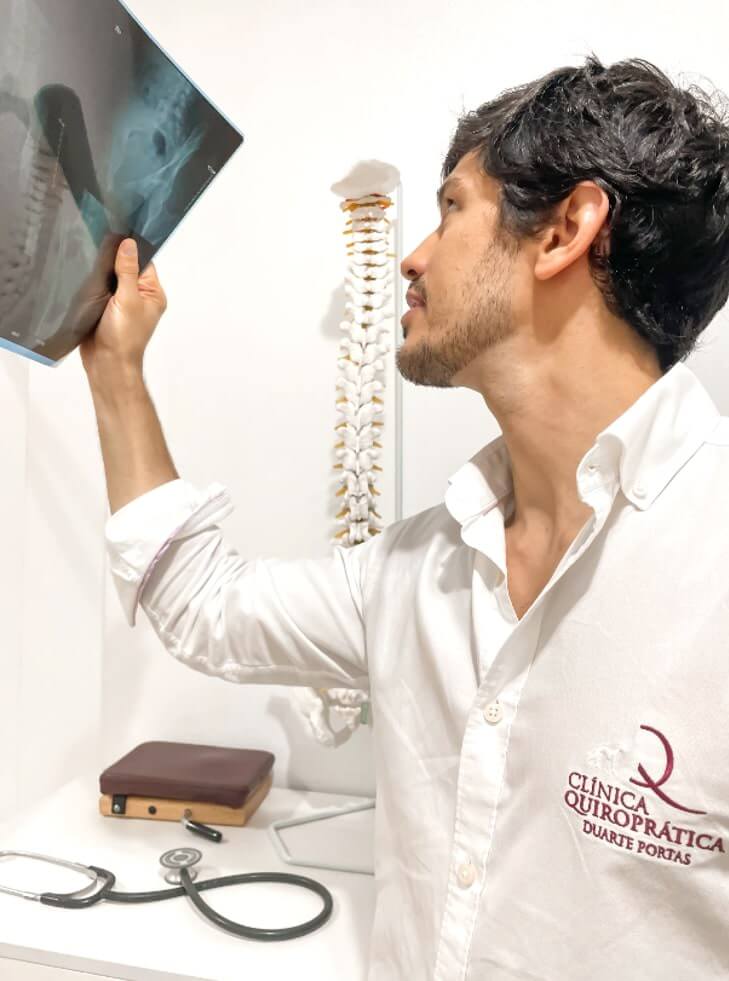Perguntas frequentes | QUiroprática
The spine is the starting point of the nervous system that connects all parts of our body.
A chiropractic subluxation occurs when a vertebra is not in its normal position, does not move optimally and/or cannot communicate properly with the brain. This condition interferes with the normal flow of information between the brain and the other organs and parts of the body.
Subluxations can therefore lead to a variety of symptoms throughout the body, in addition to local pain and inflammation and degeneration of the vertebra.
The causes for subluxations are very diverse and present in our daily life, from repetitive strain, to alcohol, contact with chemicals, stress, etc. They are therefore frequent. The main goal of the chiropractor is to find and correct these subluxations in order to restore the normal functioning of the nervous system.
See our "About Chiropractic" page for more details about the origin, effects, and correction of subluxations.
Chiropractic adjustments are manual, very specific, and controlled impulses with the main goal of correcting subluxations - interferences that exist to the optimal functioning of our nervous system - and thereby restoring and promoting the body's ability to respond, regulate, and recover.
The adjustments are most often performed in the spine, but it is also possible to adjust other parts of the body.
Most people associate a chiropractic adjustment with a "popping" sound. However, adjustments can be performed using different chiropractic techniques, some of which are gentler and do not make that sound, such as the DNFT technique. The chiropractor chooses and adapts the adjustment technique according to the characteristics of each patient.
Chiropractic does not directly treat any condition. Rather, it focuses on restoring balance and optimal function to our nervous system in order to allow natural recovery.
There are several conditions and stages in your life where chiropractic can be particularly helpful. See our "How can we help?" section:
The training of a Chiropractor is a 5 year university degree, which must be attended in person in a college that is recognized for this purpose.
This training includes areas such as anatomy, radiology, neurology, chiropractic techniques, among others. Along with the practical component, it includes a strong theoretical component, prior to any adjustment, that gives the chiropractor a solid scientific base, allowing us to safely diagnose and treat patients.
In Portugal there is no chiropractic university. The chiropractors that practice in Portugal have studied abroad.
The best way to ensure that your chiropractor is properly certified is by checking their professional registration, or more easily, through the list available from APQ - Portuguese Chiropractors Association
The adjustment of anyone's spine is a procedure that should only be done by someone with all the qualifications to do so, so we advise you to pay attention to the choice of the professional that accompanies you, in order to guarantee that the care of your spine is done in a totally safe way and with the best results.
Our joints are enveloped in a liquid - synovial fluid - that is responsible for lubricating the joint. This liquid, like many others in the body, is filled with dissolved gas molecules.
During the chiropractic adjustment, the vertebra is subjected to a quick, smooth movement that decreases the pressure in the joint, which causes the release of gasses in the synovial fluid. It is this phenomenon that causes the sound we hear during the adjustment.
Not all chiropractic techniques produce this sound, as is the case with the DNFT technique.
"The World Health Organization (WHO) considers manual mobilization and/or manipulative treatment of the spine, performed by chiropractors, to be a safe and effective treatment, with reduced, transient and very mild adverse effects."- Annals of Medicine (March 19, 2019).
Chiropractic is a non-invasive therapy and several studies over the years have proven its safety when performed by qualified professionals. The chiropractor will always perform an analysis of the patient and adapt the techniques used according to their age, physiognomy, history and physical conditions. Therefore, everyone - from 0 to 99 years old - can enjoy the chiropractic care that is right for them.
No. You may eventually feel some discomfort but, most commonly, patients find the adjustment relaxing. The technique used is always adapted to each patient for best results and comfort.
Yes, pregnancy is a time of great changes in the pelvis and spine. Not only is it common for pain and discomfort to appear or be emphasized, but the correct balance and alignment of the pelvis is essential for the correct positioning and development of the baby.
Chiropractic, besides being safe, can help you have a more comfortable pregnancy and also promote the baby's comfort and development in the womb.
Learn more here.
Yes, it is in the first years of life that our spine and nervous system develop the most and that can also lead to problems that we only experience later on.
In addition, it is typical at the time of birth for subluxations to occur in the baby, which sometimes cause symptoms such as cramps, difficulty moving the head, etc.
Chiropractic adjustment is safe from the first days of life. Adjustments in babies and children are done very gently and adapted to their age.
Learn more here.
Each session is about 30 minutes long, and the first appointment is usually longer than the others.
At your first appointment we will go over your medical history, symptoms and physical condition in order to understand what treatment is best for you. If you have had previous exams, for example X-rays, ultrasounds, MRI scans, don't forget to bring them with you or send them to us so that we can include them in the analysis. After the analysis, we will make the first adjustment. When necessary, other tests may also be requested to complete the diagnosis.



